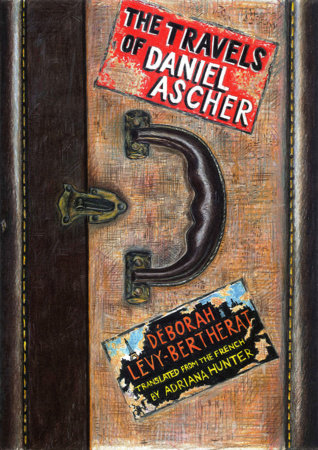The Travels of Daniel Ascher Teacher’s Guide
By Déborah Lévy-Bertherat


When twenty-year-old Hélène Roche moves to Paris to study archeology, her mysterious great-uncle Daniel Ascher loans her a room. Hélène and Daniel are seemingly polar opposites—she is quiet and serious, while he is ever the entertainer. The globetrotting author of The Black Insignia, a wildly successful series of young adult novels, he seems to Hélène to be immature, stuck in a state of arrested development. When she meets Guillaume, a devoted fan of her uncle’s novels, she finally has reason to read her uncle’s work. But Hélène finds more than adventure in his stories; she finds the key to unraveling her uncle’s dark past, a past that contains an explosive secret that could change everything she knows about herself and her family.
In immersing herself in her uncle’s writing, Hélène explores the very nature of fiction: is it a refuge, a lie, or a stand-in for mourning? The answers she finds will lead her to consider what it means to survive in the wake of insurmountable loss, and what it means to be a part of a family.
Teaching the BookHow do fiction and storytelling help us to shape our personal experiences? What effect do they have on us personally and on our relationships? The Travels of Daniel Ascher is a riveting adventure story that allows students to consider the relationship between truth and fiction and the place an individual holds in their family.
Theme Focus: Storytelling; Individual vs Group Identity
Comprehension Focus: Intertextuality
Language Focus: Revealing Adjectives
Get Ready to ReadPre-reading Activities
Preview and Predict: Discuss with students the title and cover of the book. Consider these questions:
Brainstorming: Have students write journal entries about adventure: What adventures have they gone on? What adventure stories have they read or watched? What is the appeal of adventure stories? If they could go on an adventure, what would it entail?
Vocabulary
Explain to the students that the author uses adjectives to reveal things about Daniel that he doesn’t directly tell Hélène or any of the other characters in the book. These adjectives help both Hélène and the reader to understand Daniel’s psyche and motives. The following list contains some of these words.
Ask students to look up the definition of these words as they come across them in the book. Then have them explain what the word means within the context in which it is used, and what the word reveals about Daniel.
Using Vocabulary: Ask students to refer to the definitions they wrote for the above words to answer the following questions.
Reading the Book
Modeled Reading: Read aloud the first two pages of the book, asking students to follow along. Then ask them these questions: From whose point of view is the book being told? How are Guillaume and Jonas similar? In what ways is Hélène different from Guillaume and Jonas? Do you know what Tintin and Blake and Mortimer are? Why do you think the author refers to them? Do you think Hélène is interested in stories or storytelling?
Textual Analysis: Ask students to keep these questions in mind as they read the book, and to point to passages from the book to support their answers: How does Hélène’s reaction to or opinion of the Black Insignia books change? What prompts this change? How does Hélène’s relationship with the books parallel her relationship with Daniel?
Reading Comprehension
Storytelling: Ask students to create a list of events that happened in Daniel Ascher’s life and were depicted in his novels.
After You Read QuestionsComprehension Focus
Intertextuality: How do the Black Insignia books work within the narrative of The Travels of Daniel Ascher to reveal the secrets of Daniel’s past and comment on his behavior and his relationship with Hélène?
Theme Focus
Storytelling: Daniel Roche is a writer, a storyteller. Who else tells stories in the novel, and what are the stories they tell? Other than the stories in the Black Insignia series, what stories does Daniel tell? Why do you think Daniel writes the Black Insignia series?
Individual vs Group Identity: In what ways is Hélène’s detachment or discomfort within her newfound group of friends (p 15, “Hélène laughed along with them, but she wasn’t sure it was funny”; p 27, “but her voice got lost in the racket and no one heard her”) similar to Daniel’s relationship with his adopted family? Is this alienation present in any other part of the novel?
Language Focus
Have the students choose 3-5 of the revealing adjectives from the above list and use them in a character analysis of either Daniel or Hélène.
Content Area ConnectionsHistory: Hélène’s aunt Paule tells her that Daniel made sure the Roche family was awarded the Righteous medal (p 99). Have students research French resistance to the Nazi occupation and what the Righteous medal represents.
Language Arts: Have students write a proposal for an adventure story they would like to write or read.
Arts: Have students look at images of Soutine’s work and draw a self-portrait in his style. Research Soutine or old photography tools (Daniel’s “dagger”) and styles.
Extension ActivitiesCompare and Contrast: The novel is intertextual in that it directly references adventure novels, both real and fictional (Robinson Crusoe, The Black Insignia). Ask students to consider how The Travels of Daniel Ascher compares to the books mentioned. How does the novel work as an adventure story?
About the AuthorDéborah Lévy-Bertherat lives in Paris, where she teaches comparative literature at the École Normale Supérieure. She has translated Lermontov’s A Hero of Our Time and Gogol’s Petersburg Stories into French. The Travels of Daniel Ascher is her first novel.
Just for joining you’ll get personalized recommendations on your dashboard daily and features only for members.
Find Out More Join Now Sign In